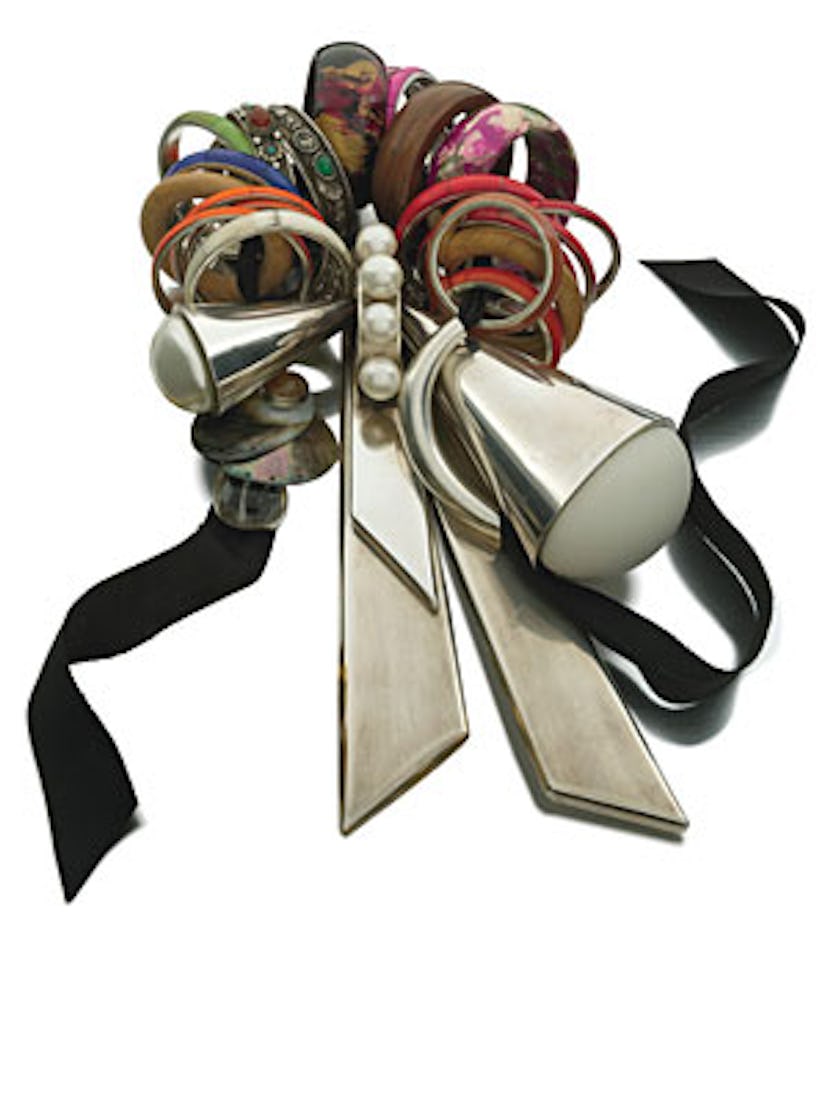Costume Drama

First, it was all about the It bag, and everyone wanted It. Ultimately, however, It fell prey to two inevitable woes: Women got sick of seeing It coming and going, and after several megahits over the course of a decade or so—the Fendi Baguette, Balenciaga Lariat and Vuitton Murakami, among others—designers struggled to continually invent the kind of blockbuster bags that resonate with vast numbers of women at the luxury level. Enter the next craze, one still in full flower: the sculptural shoe. This started back in 2006 with Balenciaga’s wedge boots, Miu Miu’s baroque wooden platforms and Marc Jacobs’s geometric wedges, to name a few. Since then, it seems that designers have engaged in an ongoing game of one-upmanship to see who can go higher, thicker, heavier and more dangerous and awkwardly asymmetric—so much so that these days, many runway shoes look like failed miniatures for Zaha Hadid projects.
Time for a new obsession? Indeed. And fashion has found it in costume jewelry, now experiencing a veritable golden age; for fall the look was big, bold and at times wonderfully inventive, not to mention all over the place. In fact, when it came to jewelry, designers were far more likely to go faux than fine. There were exceptions, notably Oscar de la Renta, whose new collaboration with Loulou de la Falaise tops out at $40,500, and Alexander McQueen, who piled on zillions of dollars’ worth of real stuff from the dazzling Gem Palace in Jaipur, India—megaglitz he’s copying in crystal and brass for retail.
The best of costume ranged from baubles that ape grandeur such as Balenciaga’s haute-y parures, faux-jeweled collars and matching cuffs to oh-so-artsy fare such as Dries Van Noten’s multiple bangles strung on ribbon and tied into necklaces. Yet for all the diversity, most designers—with the exception of Givenchy’s Riccardo Tisci and Gucci’s Frida Giannini, who went for variations on chains—favored demonstrative, structured shapes. Marni’s Consuelo Castiglioni showed flat, beaded collars and deep-toned resin floral bracelets with her pretty architectural clothes; Marc Jacobs, metal and glass bead geometrics; Vera Wang, chunky glitz; Burberry’s Christopher Bailey, bold stone works such as a bracelet with huge “sapphire” glass drops.
Of course, in the big picture, there’s really nothing new about costume jewelry; bedecking oneself with various trinkets is almost as old as walking upright. But significant jewelry had been glaringly absent from the runways for some time. Yet, just as bare legs are now passé, so, too, is the unadorned runway ensemble, as designers have taken to jewelry of major proportions with a glee not seen since the late Eighties and early Nineties, when Karl Lagerfeld piled on the pearls and chains at Chanel in irreverent homage to the house’s founder.
The current renaissance can be traced to Lanvin, where for fall 2002 Alber Elbaz showed veil-covered pearls strung on black ribbon. These resonated wildly with the fashion set, and Elbaz has continued to fuel the phenomenon, for spring offering crystals slung from grosgrain-threaded chains. He seemed to let his jewelry inspire his entire collection, built as it was around ribbons swirled into clothes that looked drop-dead gorgeous and utterly modern. What’s important in any element of fashion today, he says, is to keep the glamour but make it “user-friendly, without intellectualizing it.”
User-friendly glam is what this jewelry is all about. Since designers favored scale overt enough to captivate from a distance, real pieces so powerful would reach well into six or even seven figures. In the past, such size likely would have been deemed runway-only. But now, women want what they see. (Hence McQueen’s exotic replicas.)
“Once there was personal jewelry and there was runway jewelry, which was much bigger,” says Jacobs. “But today, everything is blown up and exaggerated.” Though he’s a champion of the flashy stuff, even Jacobs suggests a bit of restraint when piling it on. “You’re on the streets,” he cautions, “not a runway.”